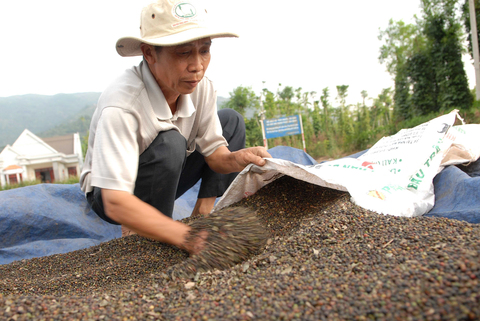
Ripened black peppercorns being sorted by hand in Quang Tri Province. — Photo rootsofpeace.org
Vietnamese pepper will face stricter scrutiny this year on excessive use of agricultural pesticides, especially in the EU and US markets, experts say.
A report by the Viet Nam Pepper Association (VPA) says the crux of the problem has been excessive amounts of Metalaxyl found in pepper exported to the EU.
In previous years, the maximum residue limits (MRL) for this chemical was 0.1 parts per million (ppm), but the European Council (EC) had been petitioning to impose an MRL of 0.05 ppm.
The European Spice Association (ESA) had informed the VPA and the Ministry of Agriculture and Rural Development (MARD) last month that it had analysed 799 samples of black pepper imported by the EU market from Viet Nam in 2016. Only 17 per cent had the permitted MRL of under 0.05 ppm.
Should this situation continue in 2017, approximately 80 per cent of Viet Nam’s pepper exports are certain to face difficulties in entering the European market, the report says.
Given that the EU has been a major buyer of Vietnamese pepper at about 40,000 tonnes a year, or 23 per cent of total annual pepper exports, this is a serious problem.
Meanwhile, the US market, which has also been importing about 40,000 tonnes of pepper from Viet Nam a year for several years now, is also set to issue new rules on the quality of imported agricultural produce, including pepper from Viet Nam.
Old mindset
The VPA report identifies quality control in pepper production and processing as a major problem, which becomes more difficult to solve when a mindset of favouring quantity over quality persists among farmers.
A majority of farmers use unnecessary amounts of fertilisers and pesticides, weakening natural resistance and requiring even higher doses of the chemicals for subsequent crops, resulting in diminishing returns.
The agriculture ministry has also asserted that clean produce must be a top priority for the sector, especially with 2017 seen as a “turning point for national socio economic development plan”.
In December 12, 2016, the EC had proposed to the World Trade Organization (WTO) that a 2005 decision on the MRL for various agricultural products including peppers be changed, and stricter conditions imposed.
Other WTO members have 60 days to protest the proposal before a decision is taken.
The VPA has been working with the agriculture ministry and concerned agencies to deal with this situation.
The VPA report says that until farmers recognise the severity of the problem and change their cultivation methods, more hardship and loss lie ahead.
Without improving the quality of pepper produced for both domestic and international markets, the industry will face falling values and increasing instability.
It says that while world demand for pepper is set to rise in 2017, larger markets will no longer accept low quality products.
In 2016, pepper prices had fluctuated significantly in the international market, but the quantity exported reached an all time high. Export turnover last year was 179,233 tonnes of assorted pepper with a value of US$1.44 billion, an increase of 34.3 per cent and 12.9 per cent in terms volume and value, respectively.
Markets with major year-on-year increases in imported value for 2016 were Pakistan (314 per cent), the Philippines (300 per cent), the US (31.3 per cent), Egypt (23.2 per cent), Spain (14 per cent) and India (12 per cent). — VNS